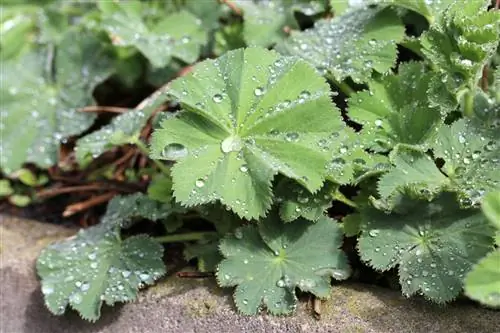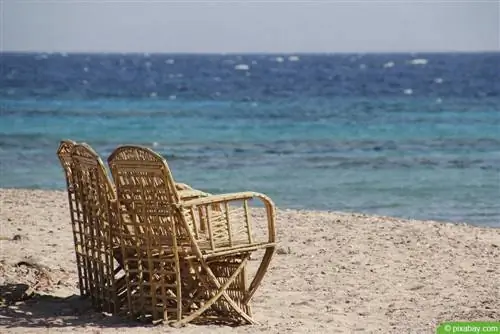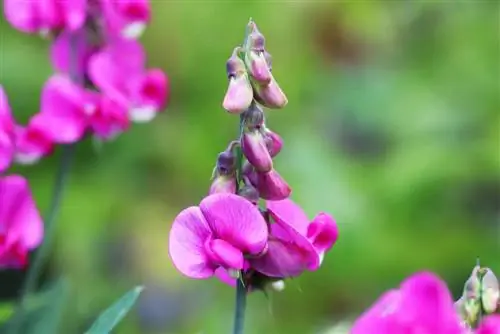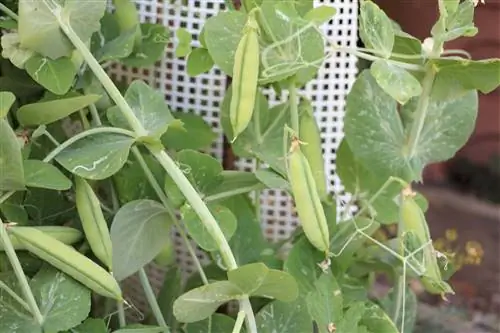- Author admin [email protected].
- Public 2023-12-17 03:39.
- Last modified 2025-06-01 06:48.
Sugar peas belong to the butterfly flowering genus and the legume family. They are climbing plants that like to climb. In Germany they are still very popular as a vegetable and are grown in many domestic gardens. Freshly harvested, they have a wonderful taste and high nutritional value.
The seeds
The seeds can be bought at garden centers and gardeners, as well as ordered online. You can find out which variety will meet your own requirements in the garden catalog or be recommended by a specialist seller.
Snow peas are now also available in garden stores for growing in pots on the balcony and terrace.
The Location
Growing sugar peas etc. has a positive effect on the garden soil because they enrich it with nitrogen. However, they don't like a lot of moisture, but without water, flowers and pea seeds cannot develop. A sunny location is ideal.
With moderate weather conditions and lots of light, a good yield can always be expected.
The Soil Claims
Sugar peas love compost-rich and deeply dug soil. The water must be able to drain easily. The soil should not be freshly fertilized with manure at the time of sowing. However, gifts of wood ash (potash fertilizer) are very good. The seeds need warm soil for a good start.
The sowing
Sowing begins with preparing the soil. So that the roots of the plants can be supplied with enough oxygen, the soil is first dug up to a depth of around 25 cm. The structure of the soil must be loose and finely crumbly.

Since sugar peas are sensitive to cold, sowing should not begin until mid-April. The optimal germination temperature is 18 degrees. For faster germination, the seeds, which must not be older than three years, can be soaked in water for a day.
The pea seeds can be laid out in the soil in two ways: in groups, 30 cm apart, the so-called “clusters”, or of 4 or 5 pea seeds, or three to five centimeters apart in a row placed. Then press the soil lightly and water. So that fresh sugar peas can be harvested until late summer, reseeding for two weeks is recommended until the beginning of July.
Peas are planted relatively deep, otherwise birds will eat them or the germs will be plucked out. Small rodents also like to help themselves, so stick cut holly branches around the plants into the seed grooves. If you have a lot of trouble with sparrows, you can also pre-cultivate the peas in pots or cover the bed with a fleece.
As soon as the young plants are 10 cm high, they are piled up to increase their stability.
Fertilization
If the beds are prepared with compost, additional fertilization is unnecessary during the growing season, as are other plant protection measures. Sugar peas are undemanding vegetable plants.
The climbing aid
Sugar peas are very climbing and require climbing support. Low varieties up to 40 cm high do not require climbing assistance. Richly branched branches stuck into the ground are very suitable as a support as a climbing aid. Wire mesh or wire strings stretched along the rows of posts are also ideal.
Care
During the growth phase and during the flowering period, the pea plants are watered well at regular intervals. However, the leaves must not be wetted.
So that weeds don't have a chance and don't hinder the development of the young plants, the bed is always chopped and weeded.
Young plants that have already grown to a height of 10 cm are piled up. A five cm high earth wall is formed around the plants.
The Harvest
The plants bloom between May and June, the first harvestable peas are available three to four months after sowing, i.e. around August.
The sugar peas can be harvested when the pea fruits are visible within the pod (shell).
You can grow the seeds for next year yourself without any effort or effort. Some pea pods should therefore be left on the plant until the end of the harvest season. Once the peas have dried and the shells have turned brown, they are removed and stored in a dry place until the next year.
After harvesting, the plants are not simply disposed of, but cut off just above the ground. The roots should remain in the ground. It contributes to a good and sufficient supply of nitrogen to the soil.
Use
The sugar peas must be consumed raw or processed immediately after harvest. They take on a bitter taste if stored for too long.
The sweet and fresh sugar peas can either be eaten raw, e.g. in salads, or fried in a pan as a vegetable and seasoned with just a little s alt. After blanching they are also suitable for freezing.
Tips worth knowing
The pea plant is relatively susceptible to powdery mildew, but with a few tricks it can easily be protected from it. The row spacing must be strictly adhered to; on the other hand, the plants must not be grown in an overly protected place, but rather in an airy place. Kohlrabi, lettuce, chard and radish are good mixed crops, as these are also grown very early. For the following year, you should definitely adhere to the following: Do not grow peas on top of peas. A recommendation for how long an area should rest is between two and three years.
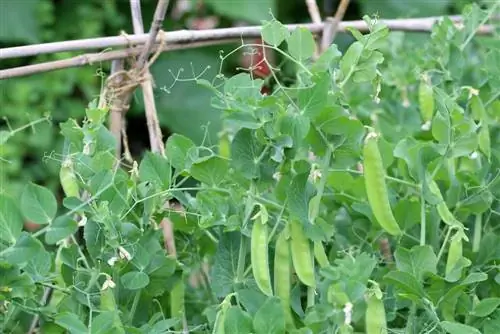
Sugar peas can be combined with carrots as a vegetable side dish. A special delicacy and typical sugar pea dish is Leipziger Allerlei.
Sow peas deeply
The pea cotyledons unfold below the surface of the soil, so the seeds should be about 5 cm deep in the soil. They are also sown quite closely, 5 cm apart in the row.
Peas on all floors
Tall pea varieties grow up to 2 m high, medium-high ones usually reach a height of 60-80 cm. The low varieties, around 40 cm high, do not require any support. But even some of the larger varieties do not need any special support, as the plants support each other with strong tendrils. The seed packet provides information about this. The low varieties can also be grown in planters.
The Art of Support
Peas climb with tendrils and can even be pulled up a scaffolding on the house wall or fence. In the bed you can let them climb up thin bamboo sticks. Richly branched branches stuck into the ground are even better as supporting brushwood. Another good solution is wire mesh strung along the rows of posts. Cultivation in double rows has proven successful. Sow two rows at a time, 25 cm apart. In between, the wire mesh is stretched lengthwise or the brushwood is inserted. The plants in both rows can climb up these supports. The next double row follows at a distance of 40 - 50 cm. Clump plants at the base of the stem once they are 10cm tall, including low and self-supporting varieties.
- Lift when pruning or e.g. B. branches that arise when breaking the lawn. They make good natural supports for peas.
- Place the branches about 5 cm next to the plants at a distance of 25 - 30 cm. Between narrow double rows you put them diagonally inwards so that they cross each other.
- Direct the young shoots to the shoots and they will soon grow up themselves. Without support, the shoots of non-self-supporting varieties would grow on the ground.
Variety recommendation
- Carouby de Maussane, tender pods and grains, tall growing
- Edula; sweet grain, especially for fresh consumption, half high
- Dehéve, early, high-yielding, tall growing
Extra tip: Warm floor for a good start
Gardeners, especially in England and France, used to use large glass bells, so-called cloches, to protect sensitive plants. You can sometimes also find them in our specialist shops. If you place them before sowing, you can warm the soil for early sowing of peas and broad beans.


